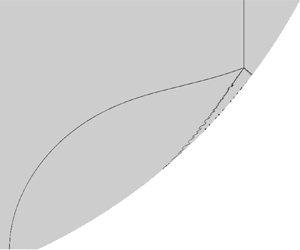Article contents
Prediction of triple point trajectory on two-dimensional unsteady shock reflection over single surfaces
Published online by Cambridge University Press: 31 August 2022
Abstract

The two-dimensional (2-D) unsteady shock reflection over a single wedge is studied theoretically and numerically, and the emphasis is placed on the trajectory of the triple point (TP). Skews’ relation and the three-shock theory are, respectively, used for determining the trajectory angles of the corner-generated disturbance and the TP, and, subsequently, a model capable of predicting the TP trajectory is established for 2-D unsteady shock reflections over a single wedge. Then, a systematically numerical study is carried out on the 2-D unsteady shock reflection over a single wedge, including five types of shock reflection with the wedge angle increased and five types of shock reflection with the wedge angle decreased. It is found that the Mach stem is always slightly concavely (convexly) curved for reflections with the wedge angle increased (decreased), which should be caused by corner-generated compression (rarefaction) waves propagating along the Mach stem. The new model reasonably predicts the TP trajectory in all the 2-D unsteady shock reflections, and its performance is related not only to the variation trend of the wedge angle (increase or decrease), but also to the type of shock and the initial wedge angle. Specifically, for the shock reflection with the wedge angle increased (decreased), the model generally provides a slightly better (worse) prediction if the TP trajectory angle calculated by the three-shock theory is compulsively modified. The shock-shock/expansion polar analysis presented can partially explain the model performance for predicting the TP trajectory.
JFM classification
- Type
- JFM Papers
- Information
- Copyright
- © The Author(s), 2022. Published by Cambridge University Press
References
REFERENCES
- 6
- Cited by



